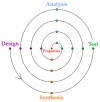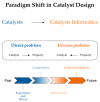Functional and Material Properties in Nanocatalyst Design: A Data Handling and Sharing Problem
- PMID: 34068386
- PMCID: PMC8153597
- DOI: 10.3390/ijms22105176
Functional and Material Properties in Nanocatalyst Design: A Data Handling and Sharing Problem
Abstract
(1) Background: Properties and descriptors are two forms of molecular in silico representations. Properties can be further divided into functional, e.g., catalyst or drug activity, and material, e.g., X-ray crystal data. Millions of real measured functional property records are available for drugs or drug candidates in online databases. In contrast, there is not a single database that registers a real conversion, TON or TOF data for catalysts. All of the data are molecular descriptors or material properties, which are mainly of a calculation origin. (2) Results: Here, we explain the reason for this. We reviewed the data handling and sharing problems in the design and discovery of catalyst candidates particularly, material informatics and catalyst design, structural coding, data collection and validation, infrastructure for catalyst design and the online databases for catalyst design. (3) Conclusions: Material design requires a property prediction step. This can only be achieved based on the registered real property measurement. In reality, in catalyst design and discovery, we can observe either a severe functional property deficit or even property famine.
Keywords: catalyst property prediction; catalysts informatics; catalytic material database; cheminformatics for material discovery; data collection; data handling in catalyst discovery; data science; data sharing in catalyst discovery; infrastructure for catalyst property prediction.
Conflict of interest statement
The authors declare no conflict of interest. The funders had no role in the design of the study; in the collection, analyses, or interpretation of data; in the writing of the manuscript, or in the decision to publish the results.
Figures













References
-
- Polanski J., Gasteiger J. Computer Representation of Chemical Compounds. In: Leszczynski J., Kaczmarek-Kedziera A., Puzyn T., Papadopoulos M.G., Reis H., Shukla M.K.K., editors. Handbook of Computational Chemistry. Springer International Publishing; Cham, Germany: 2017. pp. 1997–2039.
-
- Polanski J., Duszkiewicz R. Property Representations and Molecular Fragmentation of Chemical Compounds in QSAR Modeling. Chemom. Intell. Lab. Syst. 2020;206:104146. doi: 10.1016/j.chemolab.2020.104146. - DOI
-
- Caruthers J.M., Lauterbach J.A., Thomson K.T., Venkatasubramanian V., Snively C.M., Bhan A., Katare S., Oskarsdottir G. Catalyst Design: Knowledge Extraction from High-Throughput Experimentation. J. Catal. 2003;216:98–109. doi: 10.1016/S0021-9517(02)00036-2. - DOI
-
- Polanski J. Encyclopedia of Bioinformatics and Computational Biology. Elsevier; Amsterdam, The Netherlands: 2019. Chemoinformatics: From Chemical Art to Chemistry in Silico; pp. 601–618.
Publication types
MeSH terms
Substances
Grants and funding
LinkOut - more resources
Full Text Sources
Medical

